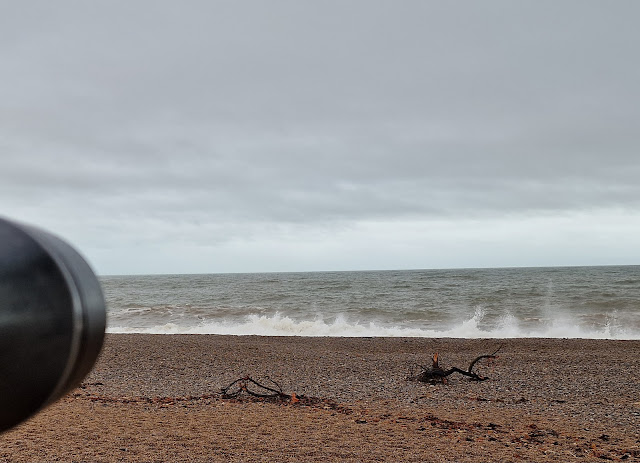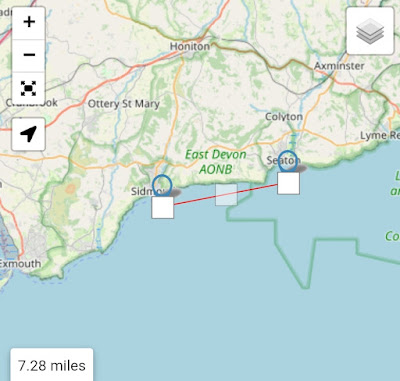I would like to thank the author of the Dawlish Warren Blog for the following line, which was posted on the eve of Thursday 2nd. I couldn't have put it better myself...
"Storm Ciaran blew through overnight and took all the birds with it".
The southerly element of the storm came through during the hours of darkness, and a couple of hours before dawn the eye of the storm passed and the wind switched to a north westerly. I knew this epic storm wasn't going to produce a lot of birds but did hope it would leave something interesting behind, but nothing at all here! Lots of big waves though despite the wind direction at daybreak, and plenty of flooding which caused a fair bit of damage in Seaton.
 |
| Looking west along Seaton Beach |
 |
| The road behind the sea front a couple of days after Ciaran |
 |
| This was an hour before hide tide on Thursday so a lot more destruction still to come. |
The mind boggles at how much more severe the damage would have been if the wind stayed southerly for a few more hours, or if this storm came during the larger tides of the previous weekend. We dodged a bullet I think, but we will not keep dodging them.
I did sea watch 06:45 - 08:00, then checked the very flooded valley. Literally nothing of note to report.
Later on in the day storm-driven sea birds, mostly Leach's Petrels, were being reported from sites mostly east of the Isle of Wight. By the end of the day several places reported three-figure Petrel counts, and it is clear to see from the track of the storm why. Storm Ciaran followed the black line in the below map and that is exactly where the seabirds were pushed too, hitting land just east of the Isle of Wight where they then carried on flying/being pushed east...
 |
| Thanks to @danholley_ for this image |
So Ciaran came and went and underwhelmed, but I could see in the forecast something else on its way. Due to make landfall on Saturday morning, a blustery southerly with lots and lots of rain expected to clear within an hour of dawn. I could just see what was going to happen...
During Friday all the places that had seen the Leach's and Euro Stormies fly east on Thursday reported several flying back west. The birds had a nice calm day and the first half of Friday night to fly west in an attempt to reorientate, and my thinking was they'd then get trapped by this fast moving very wet front forcing the already tired and battered sea birds up into Lyme Bay.
So me and my high expectations were on Seaton seafront 6:50 - 08:30 on the morning of Saturday 4th... and I was wrong.
Seven Skylark low west over the waves were the only birds smaller than a Black-headed Gull over the sea. It wasn't a bird-less sea watch, just highlight-less one with no obvious storm-driven sea birds evident.
The following went into my notebook (all west): 15 Brent Geese (all dark-bellied, flocks of 7, 2 and 6), 8 Common Scoter, 3 Kittiwake, 2 Med Gull, 1 Great Crested Grebe and several Gannets.
All a bit disappointing to be honest. I was really feeling like my hopes of a patch Leach's Petrel, a bird I haven't seen here (or anywhere) since 29th November 2009 were fading, yet again.
However, as the day went on, and whilst I was off enjoying some family-time at Budleigh Salterton, it became apparent my predication was at least semi-correct, I was just six hours out! From late morning onwards Leach's Petrels were being seen in Chesil Cove and off Portland Bill.
We were back home at about 3pm and didn't really know what to do next. The only thing I did know was that Harry was hungry and I was feeling ornithologically frustrated, so...
Shortly after 3:30pm Harry and I settled down for a picnic on Seaton Beach, as you do on a windy November day with frequent rain showers! Harry had a fully stocked lunchbox and I had my telescope...
 |
| Lunchtime! |
I knew I had as long as it would take for Harry to eat his lunch, but it turned out I didn't need that long at all!
During my second scan, over a lovely pale-coloured and far less rough sea, there was a Leach's Petrel! Mid-distance so the views were really nice as it slowly made it's way west, not in any hurry at all. I enjoyed great views of its upper side in particular, the grey carpal bar really standing out its otherwise dark upper wing, and could even make out the tail-fork and white in the rump! Having not seen a Leach's for so many years but plenty of Euro Stormies in that time, I think this made the overall shape and flight-style even more striking. It always looked in complete control, cutting through the air above the waves with ease and grace, unlike a Euro which I always think look like they are frantically flapping to remain airborne!
After a minute of good views I lost it as it dropped into a trough between waves and I just couldn't pick it up again. I used this time to message out the news, checked in with Harry who had just polished off his yoghurt, then went back to the scope. Just under five minutes later, it or another Leach's Petrel came into view. This was on the same line out from me but at a much greater distance. I couldn't pick up any plumage features on this bird, it was just a dark Leach's Petrel-shaped bird, flying like a Leach's Petrel, distantly low over the sea. From as soon as I picked it up it seemed to be flying out slightly south and I lost it about thirty seconds later. It could easily have been the same bird as the first so I will be recording it officially as '1+', but I guess it could just have easily been a second bird (which is how BirdGuides reported it!?).
About ten minutes later lunch was finished, which coincided perfectly with the arrival of a nasty squall, so we packed up and headed off. It was probably one of the best picnics I have ever been on, even though I didn't eat anything!
 |
| A happy birder and a six year old with a full tummy! |
This just proves to me that that you really do make your own luck. 4th Nov 2023 could so easily have gone down as yet another disappointing day of sea watching off Seaton, were it not for this fifteen minute window that I managed to snatch. A terrfic and highly satisfying result - my best ever Leach's Petrel views on patch!



















